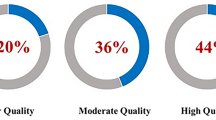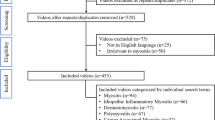Abstract
Introduction
The purpose of this study was to evaluate YouTube videos on meralgia paresthetica (MP) for reliability, quality, and differences between quality levels.
Methods
We analyzed 59 videos related to MP. We evaluated several video characteristics, including views, likes, dislikes, duration, and speaker profile. We used view ratio, like ratio, Video Power Index (VPI), Global Quality Scale (GQS), JAMA criteria, and modified DISCERN (mDISCERN) to assess viewer engagement, popularity, educational quality, and reliability.
Results
The videos received a total of 4,009,141 views (average 67,951.54), with 25.4% focused on exercise training and 23.7% focused on disease information. Mean scores were mDISCERN 2.4, GQS 2.8, and JAMA 2.1. Physician-led videos had higher mDISCERN scores, while allied health worker-led videos had more views, likes, dislikes, view ratios, and VPI. Poor and high-quality videos differed in views, likes, view ratio, VPI, and duration. Positive correlations existed among mDISCERN, JAMA, and GQS scores, with video duration positively correlated with GQS.
Conclusion
The content of YouTube videos discussing diseases significantly influences viewer engagement and popularity. To enhance the availability of valuable content on YouTube, which lacks a peer review process, medical professionals must contribute high-quality educational materials tailored to their target audience.

Similar content being viewed by others
Data availability
The data that support the findings of this study are not openly available due to reasons of sensitivity and are available from the corresponding author upon reasonable request.
Abbreviations
- AHW:
-
Allied Health Worker
- GQS:
-
Global Quality Score
- JAMA:
-
Journal of the American Medical Association
- LFCN:
-
Lateral Femoral Cutaneous Nerve
- mDISCERN:
-
Modified DISCERN
- MP:
-
Meralgia Paresthetica
- VPI:
-
Video Power Index
References
Bowley MP, Doughty CT (2019) Entrapment neuropathies of the lower extremity. Medical Clinics 103(2):371–382. https://doi.org/10.1016/j.mcna.2018.10.013
de la Caridad GY, Remotti E, Momah DU, Zhang E, Swanson DD, Kim R et al (2023) Meralgia paresthetica review: update on presentation, pathophysiology, and Treatment. Health Psychol Res 11:71454. https://doi.org/10.52965/001c.71454
Witkin LR, Gulati A, Zhang T, Karl HW (2016) Lateral femoral cutaneous nerve entrapment. In: Trescot AM (ed) Peripheral nerve entrapments. Springer, Cham, pp 667–681. https://doi.org/10.1007/978-3-319-27482-9_61
Cheatham SW, Kolber MJ, Salamh PA (2013) Meralgia paresthetica: a review of the literature. Int J Sports Phys Ther 8(6):883
Fisher A, Hanna M (1987) Transcutaneous electrical nerve stimulation in meralgia paraesthetica of pregnancy. Br J Obstet Gynaecol 94(6):603–604. https://doi.org/10.1111/j.1471-0528.1987.tb03161.x
Gomatos EL, Rehman A (2022) Sensory neuropathy. In: StatPearls [Internet]. StatPearls Publishing, Treasure Island, FL
Kalichman L, Vered E, Volchek L (2010) Relieving symptoms of meralgia paresthetica using kinesio taping: a pilot study. Arch Phys Med Rehabil 91(7):1137–1139. https://doi.org/10.1016/j.apmr.2010.03.013
Skaggs CD, Winchester BA, Vianin M, Prather H (2006) A manual therapy and exercise approach to meralgia paresthetica in pregnancy: a case report. J Chiropr Med 5(3):92–96. https://doi.org/10.1016/S0899-3467(07)60140-2
Williams PH, Trzil KP (1991) Management of meralgia paresthetica. J Neurosurg 74(1):76–80. https://doi.org/10.3171/jns.1991.74.1.0076
Elangovan S, Kwan YH, Fong W (2021) The usefulness and validity of english-language videos on YouTube as an educational resource for spondyloarthritis. Clin Rheumatol 40:1567–1573. https://doi.org/10.1007/s10067-020-05377-w
Nason GJ, Kelly P, Kelly ME, Burke MJ, Aslam A, Giri SK et al (2015) YouTube as an educational tool regarding male urethral catheterization. Scandinavian journal of urology 49(2):189–192. https://doi.org/10.3109/21681805.2014.975837
Yoo M, Hong J, Jang CW (2020) Suitability of YouTube videos for learning knee stability tests: a cross-sectional review. Arch Phys Med Rehabil 101(12):2087–2092. https://doi.org/10.1016/j.apmr.2020.05.024
Esen Özdemir E, Borman P, Mete Civelek G, Umaroğlu MM (2023) YouTube as a source of information on lipedema: property, quality, and reliability assessment. Lymphat Res Biol 21(4):403–409. https://doi.org/10.1089/lrb.2022.0028
Zure M, Korkmaz MD, Menekşeoğlu AK (2024) Exercises for fibromyalgia syndrome: what YouTube tells us as a source of information for patient and physician education. Clin Rheumatol 43(1):473–480. https://doi.org/10.1007/s10067-023-06792-5
Olson JT, Covarrubias O, Mo KC, Schmerler J, Kurian SJ, Laporte D (2023) Systematic YouTube review-trigger finger release. J Hand Surg Asian Pac Vol 28(3):342–349. https://doi.org/10.1142/S2424835523500315
Kocyigit BF, Akaltun MS, Sahin AR (2020) YouTube as a source of information on COVID-19 and rheumatic disease link. Clin Rheumatol 39:2049–2054. https://doi.org/10.1007/s10067-020-05176-3
McMahon KM, Schwartz J, Nilles-Melchert T, Ray K, Eaton V, Chakkalakal D et al (2022) YouTube and the achilles tendon: an analysis of internet information reliability and content quality. Cureus 14(4):e23984. https://doi.org/10.7759/cureus.23984
Kim J, Kim R, Jun J-S, Ahn S-H, Jung S, Minn Y-K et al (2021) Content analysis of Korean videos regarding restless legs syndrome on YouTube. J Mov Disord 14(2):144. https://doi.org/10.7759/10.14802/jmd.20137
Charnock D, Shepperd S, Needham G, Gann R (1999) DISCERN: an instrument for judging the quality of written consumer health information on treatment choices. J Epidemiol Community Health 53(2):105–111. https://doi.org/10.1136/jech.53.2.105
Kwak D, Park JW, Won Y, Kwon Y, Lee JI (2022) Quality and reliability evaluation of online videos on carpal tunnel syndrome: a YouTube video-based study. BMJ Open 12(4):e059239. https://doi.org/10.1136/bmjopen-2021-059239
Bernard A, Langille M, Hughes S, Rose C, Leddin D, Van Zanten SV (2007) A systematic review of patient inflammatory bowel disease information resources on the World Wide Web. Am J Gastroenterol 102(9):2070–2077. https://doi.org/10.1111/j.1572-0241.2007.01325.x
Akyol A, Karahan İ (2020) Is YouTube a quality source of information on sarcopenia? Euro Geriatr Med 11:693–697. https://doi.org/10.1007/s41999-020-00327-w
Gupta HV, Lee RW, Raina SK, Behrle BL, Hinduja A, Mittal MK (2016) Analysis of YouTube as a source of information for peripheral neuropathy. Muscle Nerve 53(1):27–31. https://doi.org/10.1002/mus.24916
Goyal R, Mercado AE, Ring D, Crijns TJ (2021) Most YouTube videos about carpal tunnel syndrome have the potential to reinforce misconceptions. Clin Orthop Relat Res 479(10):2296–2302. https://doi.org/10.1097/CORR.0000000000001773
Mert A, Bozgeyik B (2022) Quality and content analysis of carpal tunnel videos on YouTube. Indian J Orthop 56(1):73–78. https://doi.org/10.1007/s43465-021-00430-5
Radonjic A, Evans EL, Malic C (2020) Youtube as a source of patient information for carpal tunnel syndrome. Eur J Plast Surg 43:675–677. https://doi.org/10.1007/s00238-020-01621-3
Lama CJ, Hartnett DA, Donnelly JC, Yang DS, Kosinski LR, Katarincic JA et al (2023) YouTube as a Source of patient information for cubital tunnel syndrome: an analysis of video reliability, quality, and content. HAND 15:15589447231151428. https://doi.org/10.1177/15589447231151428
Erdem MN, Karaca S (2018) Evaluating the accuracy and quality of the information in kyphosis videos shared on YouTube. Spine 43(22):E1334–E1339. https://doi.org/10.1097/BRS.0000000000002691
Celik H, Polat O, Ozcan C, Camur S, Kilinc BE, Uzun M (2020) Assessment of the quality and reliability of the information on rotator cuff repair on YouTube. Orthop Traumatol Surg Res 106(1):31–34. https://doi.org/10.1016/j.otsr.2019.10.004
Ozsoy-Unubol T, Alanbay-Yagci E (2021) YouTube as a source of information on fibromyalgia. Int J Rheum Dis 24(2):197–202. https://doi.org/10.1111/1756-185X.14043
Chang MC, Park D (2021) YouTube as a source of patient information regarding exercises and compensated maneuvers for dysphagia. Healthcare 9:1084. https://doi.org/10.3390/healthcare9081084
Parker K, Uddin R, Ridgers ND, Brown H, Veitch J, Salmon J et al (2021) The use of digital platforms for adults’ and adolescents’ physical activity during the COVID-19 pandemic (our life at home): survey study. J Med Internet Res 23(2):e23389. https://doi.org/10.2196/23389
Güloğlu S, Özdemir Y, Basim P, Tolu S (2022) YouTube English videos as a source of information on arm and shoulder exercise after breast cancer surgery. Eur J Cancer Care 31(6):e13685. https://doi.org/10.1111/ecc.13685
Onder ME, Zengin O (2021) YouTube as a source of information on gout: a quality analysis. Rheumatol Int 41(7):1321–1328. https://doi.org/10.1007/s00296-021-04813-7
Unal-Ulutatar C, Ulutatar F (2022) YouTube as a source of information on systemic sclerosis. Int J Rheum Dis 25(8):887–892. https://doi.org/10.1111/1756-185X.14363
Longtin Y, Sax H, Leape LL, Sheridan SE, Donaldson L, Pittet D (2010) Patient participation: current knowledge and applicability to patient safety. Mayo Clin Proc 85(1):53–62. https://doi.org/10.4065/mcp.2009.0248
Ferhatoglu MF, Kartal A, Ekici U, Gurkan A (2019) Evaluation of the reliability, utility, and quality of the information in sleeve gastrectomy videos shared on open access video sharing platform YouTube. Obes Surg 29(5):1477–1484. https://doi.org/10.1007/s11695-019-03738-2
Author information
Authors and Affiliations
Contributions
The methodology of the research was determined and the research evaluations were conducted by ETC and SC. ETC ensured that the statistical analysis of the research was carried out with professional assistance. ETC prepared the figures and tables. The main manuscript was written and reviewed by ETC and SC.
Corresponding author
Ethics declarations
Conflicts of interest
None of the authors has any conflict of interest to disclose.
Ethical publication statement
We confirm that we have read the Journal’s position on issues involved in ethical publication and affirm that this report is consistent with those guidelines.
Additional information
Publisher's Note
Springer Nature remains neutral with regard to jurisdictional claims in published maps and institutional affiliations.
The research was presented as an oral presentation at the 17th Congress of the European Forum for Research in Rehabilitation 2023.
Rights and permissions
Springer Nature or its licensor (e.g. a society or other partner) holds exclusive rights to this article under a publishing agreement with the author(s) or other rightsholder(s); author self-archiving of the accepted manuscript version of this article is solely governed by the terms of such publishing agreement and applicable law.
About this article
Cite this article
Tarihci Cakmak, E., Celik, S. Characteristics, reliability, and quality of YouTube videos on meralgia paresthetica: a descriptive cross-sectional study. Acta Neurol Belg (2024). https://doi.org/10.1007/s13760-024-02567-0
Received:
Accepted:
Published:
DOI: https://doi.org/10.1007/s13760-024-02567-0




